Durgapur, West Bengal
| Durgapur | |
| — city — | |
|
|
|
| Coordinates | |
| Country | |
| State | West Bengal |
| District(s) | Barddhaman |
| Mayor | Rathin Roy |
| Parliamentary constituency | Bardhaman-Durgapur |
| Assembly constituency | Durgapur Purba,
Durgapur Paschim |
| Population • Density |
415,986 (2001[update]) • 2,701 /km2 (6,996 /sq mi) |
| Time zone | IST (UTC+5:30) |
| Area |
154 square kilometres (59 sq mi) • 65 metres (213 ft) |
| Website | bardhaman.gov.in/ |
Durgapur (Bengali: দুর্গাপুর) is a city of the state of West Bengal, India, located about 180 km from Kolkata. It was a dream child of the great visionary Dr. Bidhan Chandra Roy, the second chief minister of the state. The well laid out industrial township, designed by Joseph Allen Stein and Benjamin Polk[1] is home to one of the largest industrial units in the state, Durgapur Steel Plant, one of the integrated steel plants of Steel Authority of India Limited. Alloy Steels Plant of SAIL and CMERI, a CSIR laboratory, are also located here. There are a number of power plants, chemical and engineering industries. Some metallurgical units have come up in recent years. National Institute of Technology (Earlier known as Durgapur Regional Engineering College), Durgapur is one of the prominent seats of Engineering and Technological Educations of the country.
Contents |
Geography
Durgapur is located at .[2] It has an average elevation of 65 metres (213 ft).
Durgapur is situated on the bank of the Damodar River, just before it enters the alluvial plains of Bengal. The topography is undulating. The coal-bearing area of the Raniganj coalfields lies just beyond Durgapur, although some parts intrude in to the area. The area was deeply forested till recent times, and some streaks of the original forests are still there, standing witness to its wild past.
Two mighty rivers border it on the north and south. The Ajay River flows past unhindered in the north but the Damodar River on the south has two obstacles in its path – an earlier anicut at Rondia and a massive 692-metres long Durgapur Barrage at Durgapur, constructed in 1955 and controlled by Damodar Valley Corporation. Two rivulets, Singaran and Tamla, flow through the area and join the Damodar River. Two other rivulets in the area, Kunur and Tumuni, join the Ajay River.
Durgapur subdivision is surrounded by Asansol subdivision on the west, Bardhaman Sadar North subdivision on the east, Bankura district across the Damodar in the south, and Birbhum district across the Ajay River to the north.
The Grand Trunk Road (NH2) virtually bifurcates the area. This historically important arterial connector has now been widened into 2+2 Lane Highway as part of the Golden Quadrilateral project. Another wide road takes off from Darjeeling Morh near Panagarh for North Bengal. It also links Santiniketan to the Grand Trunk Road. The Durgapur Expressway, linking Dankuni with Memari on Grand Trunk Road, now allows fast communication between Kolkata and Durgapur, where one can maintain cruising speeds of 80-120 Km/hr. A road over the Durgapur Barrage links Durgapur with Bankura and beyond in South Bengal.
The important superfast railway track connecting Kolkata and Delhi passes through Durgapur. Andal Junction, about 15 km from Durgapur has a link with Sainthia on the Sahibgunj loop line. There are airstrips at Panagarh and Durgapur, the former with the Indian Air Force and latter with SAIL. A full-fledged domestic airport is coming up near Durgapur. The airport is expected to be operational by 2011.
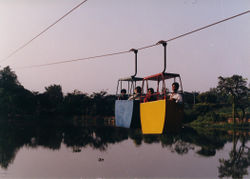
Demographics
As of 2001 India census,[3] Durgapur had a population of 492,996. Males constitute 53% of the population and females 47%. Durgapur has an average literacy rate of 75%, higher than the national average of 59.5%: male literacy is 81% and, female literacy is 69%. In Durgapur, 10% of the population is under 6 years of age.
Language
Durgapur is a predominantly Bengali speaking city. However Hindi and English are also understood to a fair extent.
Transport
Durgapur is well connected via roads. It is also well connected by rail to major parts of India such as Delhi, Mumbai, Chennai, Indore, Bhopal, Jabalpur, Nagpur, Guwahati, Amritsar, Jaipur, Lucknow, Kanpur etc. Long distance buses connect Durgapur to places like Jamshedpur, Dhanbad, Bokaro, Siliguri, MaldaTown etc.
Due to its industrial and commercial importance, Durgapur city is connected to almost all major places of Bengal. Express/Mail trains and couple of inter-city superfast trains ply between Kolkata and Durgapur on a regular basis. The Sealdah Rajdhani Express and the Howrah Ranchi Shatabdi express also stops here. Poorva Express, Kalka Mail, Amritsar Mail, Mumbai Mail, Doon Express etc. are some important trains stopping at Durgapur. There are regular and frequent bus services available between Kolkata and Durgapur. The buses usually leave from Kolkata bus terminus at Esplanade, Kolkata or the Salt Lake Karunamoyee bus stand. One is, though, more likely to get a bus from the Esplanade, Kolkata. There are buses to suit every pocket namely (in ascending order of ticket cost) - Non-A/C buses (cheap, max journey time, more interim stoppages), A/C buses (faster, more comfortable, costlier) and the Luxury Volvo Buses (non-stop, fastest, most comfortable, costliest). In a Volvo, the journey takes about 3 hours. The journey is very comfortable as the Durgapur Expressway toll road, on which the buses ply for a major part of their journey and then the NH-2 are one of the best maintained roads in the country. Due to it being so well connected by road and rail, Durgapur is also the preferred gateway to the districts of Bankura, Birbhum, Purulia etc. which are not so well connected.
Within the city of Durgapur private mini-buses are cheapest and most convenient mode of communication. Recently CNG autos have been introduced plying between City Center and various parts of the city. They are non-polluting, environment friendly, convinient, less time-consuming and cheap mode of transport. Cycle-rickswaws are available for travelling smaller distances, as a preferred commute.
Nearest International Airport is at Dumdum, Kolkata (Netaji Subhash Chandra Bose International Airport); a smaller private air strip at Panagarh belonging to the Indian Air Force is rarely used. A new airport is coming up in Andal (10 km from Durgapur). It is expected to be completed in the next two years.
Climate
The district experiences a climate which is transitional between CWg3 and AW1 types(according to Köppen climate classification), where 'C' stands for 'warm temperate rainy climates with mild winter', 'W' for 'dry winter not compensated for by total rain in the rest of the year', 'g3' for 'eastern Ganges type of temperature trend' and 'AW1' for 'tropical savanna climates'. Average temperature during summer season is 32 °C while at the cold season is 20 °C. The maximum temperature during summer rises up to 45 °C while minimum temperature during winter comes down to 60C. Average rainfall is 150 millimetres with the bulk of rainfall occurring around the July-September period. The normal trend is - winter season starts from about the middle of November and continues till the end of February. March to May is dry summer intervened by tropical cyclonic storms. June to September is wet summer while October is autumn.
History
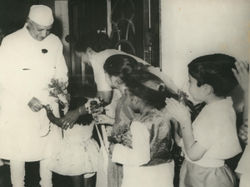
Mighty emperors reigned in this region over the centuries but it is difficult to pinpoint as to who exactly held sway over the area at different points of time. Historians talk of this region being a part of the Maurya and Gupta empires, the empire of Harsha Vardhan and the Mughals. Being a geographical border region, it could have been on either side of the virtually unmarked and flexible borders of the mighty empires. Moreover, the infertile soil with deep impenetrable forests and wild animals was probably not a very inviting proposal for any emperor on the look out for wealth and treasures. Even when coal mining made forays into the adjoining Asansol-Ranigunj area from the late eighteenth century, and factory chimneys reared their heads in the sky somewhat later, Durgapur remained an impenetrable jungle that few dared to trespass into.
In the mid-nineteenth century, the railway track traversed the Durgapur area but even fairly recent pre-independence travellers describe Durgapur as a small station, with dim kerosene lanterns burning at night, where only a few passenger trains stopped. It was local chieftains such as Bhabani Pathak and Ichhai Ghosh, who were the heroes of the jungle-territory, and probably held many a great emperor at bay. Many of them must have passed through the area on the look out for wealth in the famed granaries of Bengal further east but probably never found the place attractive enough to show their prowess.
It is unlikely that Bhabani Pathak of Durgapur was the same person linked with Devi Choudhurani, made famous by Bankim Chandra Chatterjee. Their area of activity was around Rangpur, now in Bangladesh. Although barges used to carry coal down the Damodar in those days and the river was more navigable than now, the area was never a watery haven as some areas of east or north Bengal were. However, legends have more impact on people than the hard realities of history.
The area was part of the Bardhaman Raj, who ruled on the basis of a firman from the Mughal emperor. Mir Kassem, then Nawab of Sube Bangala, ceded Bardhaman along with Medinipur and Chittagong to the East India Company in 1760 (three years after the Battle of Plassey), and the Bardhaman Raj continued to function under British tutelage.
However, there are some interesting historical points. Archeological excavations at Birbhanpur, on the bank of the Damodar, have revealed a number of stone implements. These are dated to be around 5,000 BC. Many of these are hunting implements used by pre-historic hunters. Earlier, some of the excavations at Pandu Rajar Dhibi, on the banks of the Ajay, just beyond Durgapur but in Bardhaman district, revealed traces of a civilisation possibly linked with the Indus Valley Civilisation. These are important historical finds and are yet to be fully explored.
Industrialisation
Durgapur is by far, the most industrialised city in the entire eastern India. It all started with the dreamer first Prime Minister of independent India, Jawaharlal Nehru. His dream of transforming the backward agricultural country into an industrially advanced nation was picked up in West Bengal by Dr. B.C. Roy. At the earlier stages for the selection of a proper site for a new industrial township, Jnananjan Niyogi, a great business organizer and planner, was involved. Modernist American architect [Joseph Allen Stein], invited to head the newly formed Department of Architecture and Planning at the Bengal Engineering College in Calcutta, plunged into a major project as soon as he reached India in 1952—the designing of Durgapur city along with Benjamin Polk,
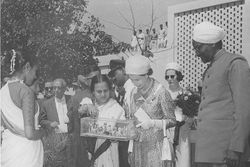
another American architect already living in Calcutta at that time. Thereafter it was the task of local leaders such as Ananda Gopal Mukherjee and bureaucrats such as K.K. Sen to get Durgapur going.
Prior to independence, only one small refractory plant of the Martin Burn group was located at Durgapur, the abandoned chimney of which is still visible near the station. Damodar Valley Corporation constructed Durgapur Barrage in 1955 and shortly followed with the Durgapur Thermal Power Station.
There was a massive follow up – Durgapur Steel Plant (commissioned 1960), Alloy Steels Plant (commissioned 1965), Durgapur Projects Ltd. (established 1961), Mining and Allied Machinery Corporation, ACC-Vickers Babcock (later ACC-Babcock and now Alstom Power Boilers Ltd.), Hindustan Fertiliser Corporation, Philips Carbon Black Ltd., Sankey Wheels (a unit of GKW), Bharat Ophathalmic Glass Ltd, Durgapur Cement Ltd. (now Birla Cement) (established 1975), Graphite India Ltd. (established 1967), Durgapur Chemicals and many others. A great new industrial city was bubbling with enthusiasm.
Durgapur Steel Plant was a showpiece of Indo-British cooperation in independent India. Dr. Rajendra Prasad, the first president of India, came for the inauguration of the first blast furnace. Prime Minister Jawaharlal Nehru was a regular visitor. He called these plants temples of new India. Many senior leaders and important foreign leaders visited Durgapur to see and to cheer. Displaying a rare gesture of solidarity, Queen Elizabeth came on a state visit.
As the numerous chimneys merrily belched out smoke – black, white and reddish brown – as pollution control norms were still some way off (for the past few years all the 65 chimneys of Durgapur Steel Plant are pollution free), the townships grew and prospered. Regional Engineering College (established 1960) (now renamed National Institute of Technology) and Central Mechanical Engineering Research Institute (established 1958) added to the stature of the new township. Schools, hospitals, parks, and playgrounds – all came up. It was new life in new India.
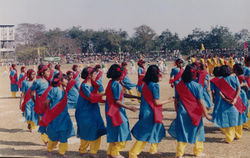
The Revival
As the British industrialists left India after independence many of the industrial empires they left behind were taken over by the Indian business community, who were mainly traders. With technological obsolescence the industries fell on bad times, labour unrest started and finally engulfed the state of West Bengal in the late sixties. Even the new industries in Durgapur were affected by the militancy and in no time, most of the industries in Durgapur were in shambles.
That continued for some years but the result was that many of the sick industries were on the verge of closure. It was evident that some of the industries were technically unsound; as for example, Durgapur Steel Plant was technologically obsolete and needed huge investment for modernization. The political chaos submerged all such concerns and no investor considered the region safe for any major investment. When unemployment started pinching, the left was settled comfortably in power. There was rethinking about revival of industries in West Bengal.
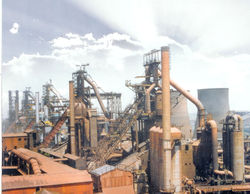
The late eighties witnessed a turn around in the fortunes of SAIL, with Durgapur Steel Plant being one of the plants to be modernized at a cost of Rs. 5,000 crore. However, The plant continued to make huge operating losses and by mid-nineties even rumours of a slow death of the plant along with the city was making the rounds.
Fortunately, DSP management with public support of the trade unions was able to turn around the dire situation with thousands of job cuts through voluntary retirement schemes and modernizing efforts. Now Durgapur Steel Plant is operating at above its rated capacity and earning profits after deduction of substantial amount of interest and depreciation resulting from the massive investment in modernisation. The plant is undergoing further expansion and is all set for a momentous future. A number of other industries, as for example Alstom Projects India Limited (erstwhile ACC-Babcock Ltd), Philips Carbon Black Ltd. and Graphite India Ltd., had been doing well. Alloy Steels Plant has also turned the corner. Therefore, Durgapur presents a dual picture of growth and hope on one side and collapse on the other. The darker side covers such units as MAMC, Bharat Ophthalmic and Hindustan Fertiliser Corporation.
Recent Changes in Durgapur
2002 onwards, Durgapur has been witnessing radical changes, with rapid development in different segments like Industry, Real estates , IT, Education etc. The changes are with respect to infrastructure as well as industrial growth for steel (direct reduced iron), metal, cement industries & knowledge based industries.
Durgapur during the last five years got more than 12 Engineering and Technology, management as well as professional study colleges (under graduate level). Housing co-operatives and flats, shopping malls, multiplex, science and energy park, Software Technology park (STPI), Hotels and stadiums have also come up. In 2007, a shopping mall by ADDA, named Suhatta was opened by Chief Minister Budhadeb Bhattacharya. He inaugurated 7 institutes that day including a Polytechnic college and Hotel GINGER. Currently Durgapur several Shopping malls and multiplex.
During the years 2001-2007 Durgapur saw the setting up of 10 to 15 middle/ large scale industrial investment in iron and steel manufacturing sector including value added products like sponge iron, Wire Rod, TMT bar (Thermo Mechanical Treatment) for construction, Iron Casting powder etc. The prominent investors are MB Group, Jai Balaji group, SPS group, Adhunik Group of Industries, Neo Metallic, Stolberg India, Super Smelters Ltd, Shyam Steel, UltraTech Cement etc.
Some other important changes are Regional Engineering College being upgraded to National Institute of Technology - the first Deemed University in Durgapur, 'SRIJONI'- a public hall equipped with technically advanced systems (audio & video).
City Centre has now grown to be the most happenning place in Durgapur and most people desire to reside there.
An Airport City - Aerotropolis (an integrated city with contemporary infrastructure for industries, logistics hub, IT, hospitality, healthcare, education, retail and residential) is being developed by Bengal Aerotropolis Projects Limited (BAPL) at Andal near Durgapur. The project is being developed over an initial 2182 acres. The Airport, as part of this Aerotropolis, is designed by the world-renowned Changi Airports of Singapore who will also operate the Airport for an initial period of about 2 years. The Ministry of Civil Aviation, Government of India has already granted "In Principle Clearance" to the project developers for this Airport at the proposed site near Andal.
Software giants like Wipro, TCS are moving towards Durgapur. DLF and Shapoorji Pallonji are investing millions for integrated townships and IT Park. The IT park has been named as Infocity. IT firms like Hinduja Global Solutions Limited have already made Durgapur as its Eastern Developmental Centre. A mall, called the Junction is coming up.
Administrative changes
Durgapur is a new industrial city. The administrative setup for the city came up in stages. Once the British settled down to ruling the country in the nineteenth century, they started effecting administrative changes. In 1837, when Bankura district was formed, Durgapur area was part of it. In 1847, Ranigunj subdivision was formed with three police stations – Ranigunj, Kanksa and Neamatpur - and it was made a part of Bardhaman district. In 1906, the subdivisional headquarters was shifted to Asansol and the subdivision renamed accordingly. In 1910, the police stations in Asansol subdivision were Asansol, Ranigunj, Kanksa, Faridpur and Barakar. On 14 April 1968, Durgapur subdivision was carved out of Asansol subdivision.
Durgapur being an industrial city, the civic amenities of different company/ plant townships are taken care by the respective company/ plant authorities. However, there are civil localities such as the area around the railway station (what was the original Durgapur), the City Centre,Sepco, Bidhannagar, Benachitty, Muchipara and so on, which need civic facilities. In 1962, Durgapur Notified Area Authority was formed for the purpose. It was upgraded to a municipal corporation on 7 October 1996 and the company/ plant townships included in it, although civic amenities continue to be provided by the respective companies/ plants.
Education
Durgapur has many reputed educational institutions. Prominent schools include Durgapur Project Boys High School(Day and Morning Section), St. Michael's school, DAV Model, St. Xavier's, St. Peter's, Carmel (Steel) and Carmel (MAMC), Hem Sheela Model School, Pranavananda Vidya Mandir, AG Church ,Guru Teg Bahadur Public School,DIST and Bidhan Chandra Institution. A-Zone M.P. Boys High School, B-Zone M.P.Boys High School, Kashiram Das Road Boys High School, Joydev Boys, Joydev Girls,GMPS,Akbar Road Girls High School
National Institute of Technology, Durgapur, previously an RE College is a premier institution in Eastern India. It is one of the 20 prestigious NITs in the country. NSHM Knowledge Campus is a well known college in Durgapur region, Dr. B. C. Roy Engineering College, Durgapur is also a very known college. Other notable colleges are Aryabhatta Institute Of Engineering And Management Durgapur [www.aiemd.in], Durgapur Institute Of Advanced Technology And Management, which is better known as DIATM,Kanksa Academy of technology and Management, also known as KATM, Bengal College of Engineering and Technology, Institute of Engineering & Industrial Technology, Durgapur (IEIT), Durgapur Government College are under the University of Burdwan. Durgapur Government College is the only NAAC-accredited college in the region, and received a grade of B++. DSMS is best managament college in durgapur and also it is premier management college of eastern India (creating careers for 20 years). Nowadays National Institute of Management, popularly known as NIM Durgapur, is making a debut in the field of education. An ISO certified college approved by PTU. National Power Training Institute[N.P.T.I(E.R.)], previously known as pets is also a premier engineering and technical institute in the region. Situated in City Center, under the Ministry of Power(Govt. of India),[4] it offers courses in power engineering, post graduate diploma course and PDC.
Places of interest
- Bhabani Pathak’s Tilla – near city centre of Durgapur. Earlier there was a tunnel system from here to the Damodar River, but now that is closed from public view. Now, people can visit only the Tilla.
- Rahreswar Shib Mandir – 800 years old temple complex on the Muchipara-Shibpur road.
- Ichhai Ghosh’s garh - It is a fort – now in ruins - and the Shyamarupa temple.
- Santiniketan – location of Visva Bharati, established by Rabindranath Tagore. It is about 60 km away from Durgapur.
- Bishnupur – the famous terracotta temple town and home to major art and crafts. It is about 70 km away from Durgapur. The Bankura horse, symbol of Indian handicrafts is produced at Panchmura, near Bishnupur. It is also the home of the Baluchari sari, originally woven with motifs based on stories from the Ramayana and the Mahabharata, but now modernized.
- Jaydev Kenduli – temple and birthplace of Sanskrit poet Joydeb, on the banks of the Ajay River. This place is about 30 km away from Durgapur. On the occasion of Makar Sankranti (Winter Solstice), a fair is organized here. Bauls, religious singers with a detached philosophy and spontaneity of their own, participates in this fair, which is held in mid January every year.
- Bakreshwar – a hot spring and temple, lying about 60 km away from Durgapur.
- Churulia - birthplace of the famous Bengali poet Kazi Nazrul Islam. He is considered the national poet of Bangladesh. The village is about 60 km from Durgapur, and contains a museum with his works and a memorial for him.
- Durgapur Barrage – A dam and a tourist spot on river Damodar.
- Dreamplex- Its a shopping complex where the young crowd hangs. It contains the Big Bazar 89 cinemas and other shopping and entertainment spots.
- '"Suhatta"' is another shopping complex intended for the higher social class which has famous brands & designer retail outlets.
- City Centre This is the only central business district of the city,and is the costliest area of the city.
Non-Governmental Organisation
- Swami Vivekananda Vani Prachar Samity: Influenced by the teachings of Swami Vivekananda, few likeminded people of Durgapur Steel Township
References
- ↑ A built legacy
- ↑ Falling Rain Genomics, Inc - Durgapur
- ↑ "Census of India 2001: Data from the 2001 Census, including cities, villages and towns (Provisional)". Census Commission of India. Archived from the original on 2004-06-16. http://web.archive.org/web/20040616075334/http://www.censusindia.net/results/town.php?stad=A&state5=999. Retrieved 2008-11-01.
- ↑ www.nptidurgapur.com
Rarh Bangala Katha Sahitya Akademi is a premier literary organisation whose head office is situated in durgapur. Its founder members are Biman Chatterjee, Sujit Chatterjee, Subir Ghosh, Subodh Ghosh, Parthajit Bhakta and Ashoke Tanti. The organisation encourages budding writers. Provides prizes on literary works.
External links
|
||||||||||||||||||||||||||

